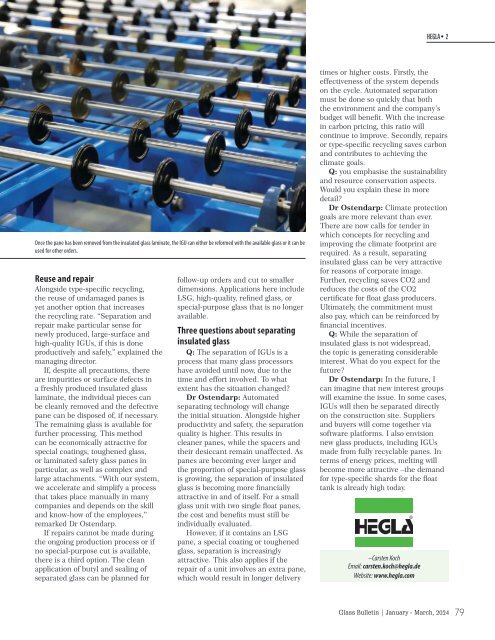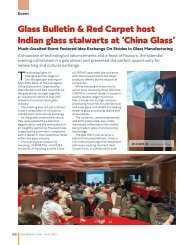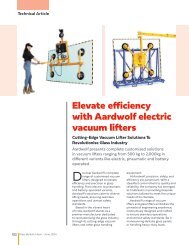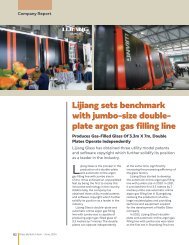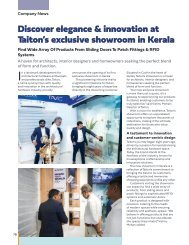Edition 73 (January-March, 2024)
GLASS BULLETIN is a publishing company, managed by a highly experienced editorial and administrative staff. It has a dedicated and responsible team for providing quality journals and related services to its readers. The company publishes GLASS BULLETIN which is the fastest growing top-notch journal of India for the global glass industry. It is published quarterly and circulated among glass manufacturers, glass processors, glass-machinery & tool manufacturers, art glass processors, glass dealers, architects, builders, aluminium fabricators, interior decorators and the automobile industry across the globe. GLASS BULLETIN is the ideal platform, both in the print and digital media, for worldwide exposition of news, reports, products and exhibitions related to the glass industry. It is a one-stop solution for all queries and needs related to glass–machinery and technology, its innovation, product-procession and marketing in India. By its permanent columns, it enjoys the status of highest readership among all Indian glass journals. GLASS BULLETIN is the media partner for international glass exhibitions in Beijing, Shanghai and Guangzhou in China besides in other parts of the world, including Europe, India and the Middle East. GLASS BULLETIN e-magazine, the first glass-related e-magazine of India, is also available online and on mobile phone, free of cost at http://www.glassbulletin.com
GLASS BULLETIN is a publishing company, managed by a highly experienced editorial and administrative staff. It has a dedicated and responsible team for providing quality journals and related services to its readers. The company publishes GLASS BULLETIN which is the fastest growing top-notch journal of India for the global glass industry. It is published quarterly and circulated among glass manufacturers, glass processors, glass-machinery & tool manufacturers, art glass processors, glass dealers, architects, builders, aluminium fabricators, interior decorators and the automobile industry across the globe.
GLASS BULLETIN is the ideal platform, both in the print and digital media, for worldwide exposition of news, reports, products and exhibitions related to the glass industry. It is a one-stop solution for all queries and needs related to glass–machinery and technology, its innovation, product-procession and marketing in India. By its permanent columns, it enjoys the status of highest readership among all Indian glass journals.
GLASS BULLETIN is the media partner for international glass exhibitions in Beijing, Shanghai and Guangzhou in China besides in other parts of the world, including Europe, India and the Middle East.
GLASS BULLETIN e-magazine, the first glass-related e-magazine of India, is also available online and on mobile phone, free of cost at http://www.glassbulletin.com
You also want an ePaper? Increase the reach of your titles
YUMPU automatically turns print PDFs into web optimized ePapers that Google loves.
HEGLA• 2<br />
Once the pane has been removed from the insulated glass laminate, the IGU can either be reformed with the available glass or it can be<br />
used for other orders.<br />
Reuse and repair<br />
Alongside type-specific recycling,<br />
the reuse of undamaged panes is<br />
yet another option that increases<br />
the recycling rate. “Separation and<br />
repair make particular sense for<br />
newly produced, large-surface and<br />
high-quality IGUs, if this is done<br />
productively and safely,” explained the<br />
managing director.<br />
If, despite all precautions, there<br />
are impurities or surface defects in<br />
a freshly produced insulated glass<br />
laminate, the individual pieces can<br />
be cleanly removed and the defective<br />
pane can be disposed of, if necessary.<br />
The remaining glass is available for<br />
further processing. This method<br />
can be economically attractive for<br />
special coatings, toughened glass,<br />
or laminated safety glass panes in<br />
particular, as well as complex and<br />
large attachments. “With our system,<br />
we accelerate and simplify a process<br />
that takes place manually in many<br />
companies and depends on the skill<br />
and know-how of the employees,”<br />
remarked Dr Ostendarp.<br />
If repairs cannot be made during<br />
the ongoing production process or if<br />
no special-purpose cut is available,<br />
there is a third option. The clean<br />
application of butyl and sealing of<br />
separated glass can be planned for<br />
follow-up orders and cut to smaller<br />
dimensions. Applications here include<br />
LSG, high-quality, refined glass, or<br />
special-purpose glass that is no longer<br />
available.<br />
Three questions about separating<br />
insulated glass<br />
Q: The separation of IGUs is a<br />
process that many glass processors<br />
have avoided until now, due to the<br />
time and effort involved. To what<br />
extent has the situation changed?<br />
Dr Ostendarp: Automated<br />
separating technology will change<br />
the initial situation. Alongside higher<br />
productivity and safety, the separation<br />
quality is higher. This results in<br />
cleaner panes, while the spacers and<br />
their desiccant remain unaffected. As<br />
panes are becoming ever larger and<br />
the proportion of special-purpose glass<br />
is growing, the separation of insulated<br />
glass is becoming more financially<br />
attractive in and of itself. For a small<br />
glass unit with two single float panes,<br />
the cost and benefits must still be<br />
individually evaluated.<br />
However, if it contains an LSG<br />
pane, a special coating or toughened<br />
glass, separation is increasingly<br />
attractive. This also applies if the<br />
repair of a unit involves an extra pane,<br />
which would result in longer delivery<br />
times or higher costs. Firstly, the<br />
effectiveness of the system depends<br />
on the cycle. Automated separation<br />
must be done so quickly that both<br />
the environment and the company’s<br />
budget will benefit. With the increase<br />
in carbon pricing, this ratio will<br />
continue to improve. Secondly, repairs<br />
or type-specific recycling saves carbon<br />
and contributes to achieving the<br />
climate goals.<br />
Q: you emphasise the sustainability<br />
and resource conservation aspects.<br />
Would you explain these in more<br />
detail?<br />
Dr Ostendarp: Climate protection<br />
goals are more relevant than ever.<br />
There are now calls for tender in<br />
which concepts for recycling and<br />
improving the climate footprint are<br />
required. As a result, separating<br />
insulated glass can be very attractive<br />
for reasons of corporate image.<br />
Further, recycling saves CO2 and<br />
reduces the costs of the CO2<br />
certificate for float glass producers.<br />
Ultimately, the commitment must<br />
also pay, which can be reinforced by<br />
financial incentives.<br />
Q: While the separation of<br />
insulated glass is not widespread,<br />
the topic is generating considerable<br />
interest. What do you expect for the<br />
future?<br />
Dr Ostendarp: In the future, I<br />
can imagine that new interest groups<br />
will examine the issue. In some cases,<br />
IGUs will then be separated directly<br />
on the construction site. Suppliers<br />
and buyers will come together via<br />
software platforms. I also envision<br />
new glass products, including IGUs<br />
made from fully recyclable panes. In<br />
terms of energy prices, melting will<br />
become more attractive –the demand<br />
for type-specific shards for the float<br />
tank is already high today.<br />
–Carsten Koch<br />
Email: carsten.koch@hegla.de<br />
Website: www.hegla.com<br />
Glass Bulletin | <strong>January</strong> - <strong>March</strong>, <strong>2024</strong> 79


